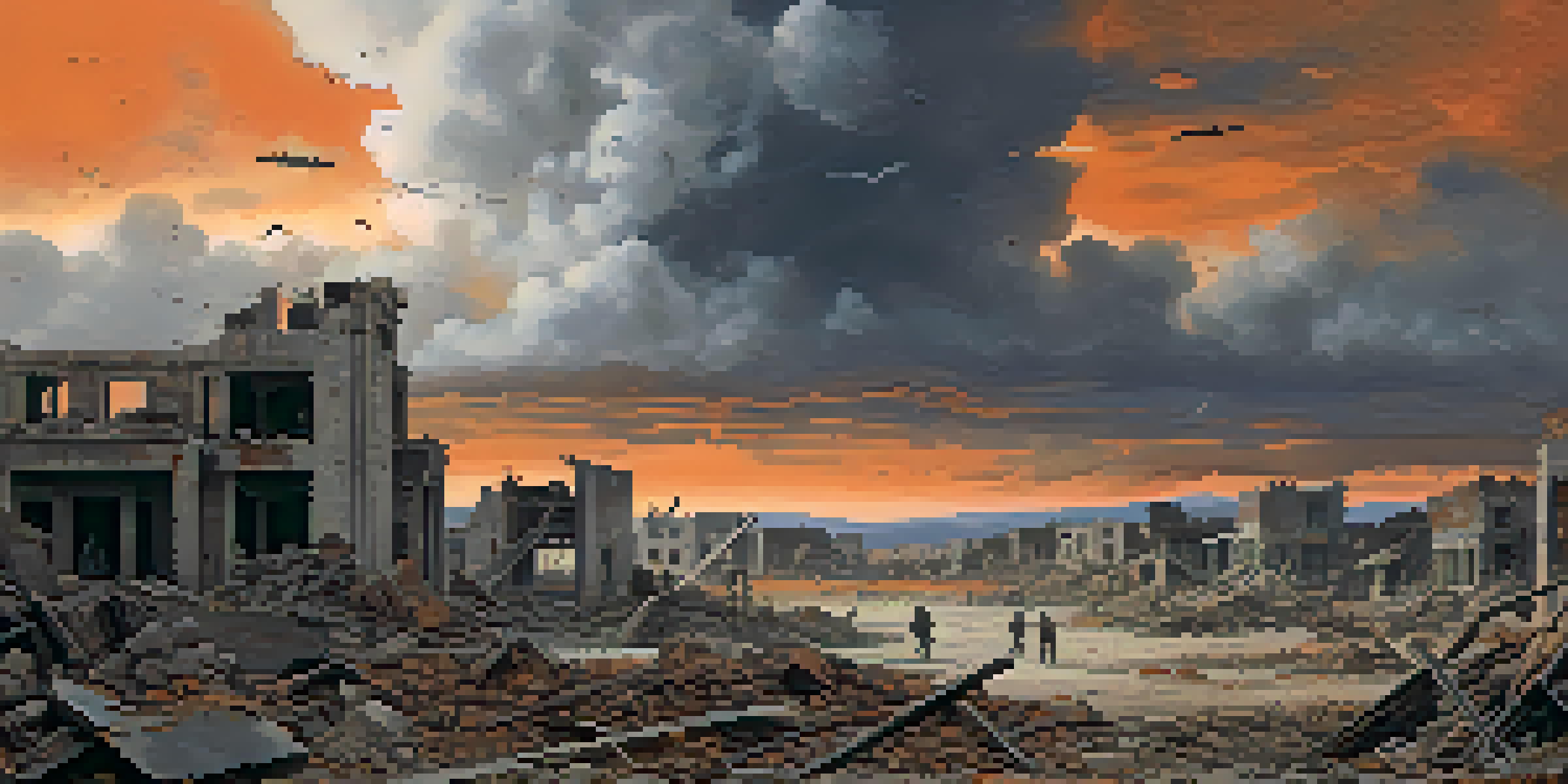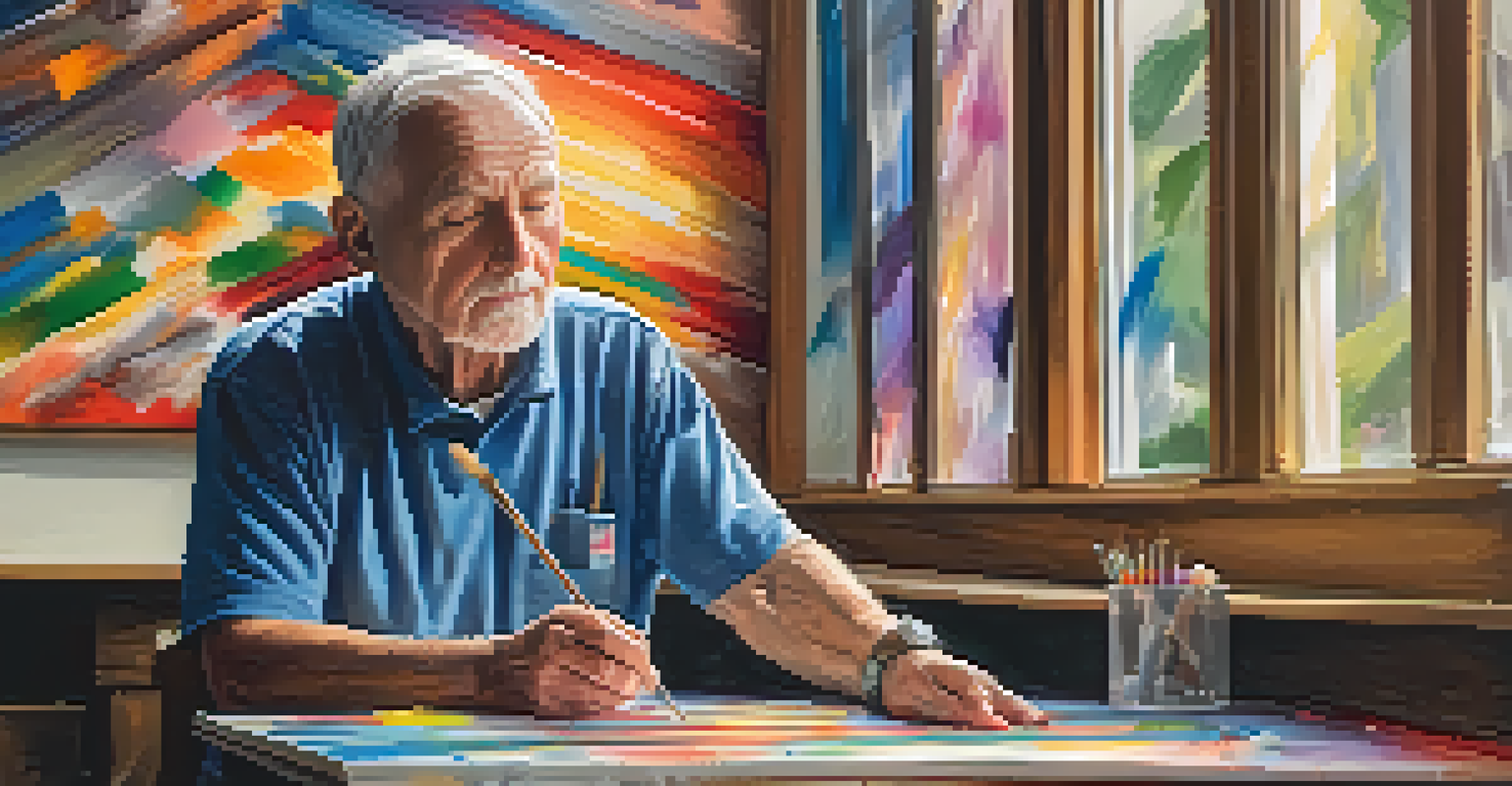Artistic Responses to War: A Reflection on Political Conflict

The Power of Art in Times of Conflict
Art has always held a mirror to society, especially during tumultuous times. When war erupts, artists often become the chroniclers of human experience, capturing the chaos, pain, and resilience. This unique ability to convey deep emotions makes art a powerful tool for reflection and understanding.
Art is the most beautiful of all lies.
From paintings to poetry, artistic expressions provide a voice to those affected by conflict. They help to humanize the statistics and stories behind war, allowing audiences to connect on a personal level. By engaging with art, we can gain insights into the emotional landscapes of individuals living through war.
Furthermore, art often serves as a form of protest, challenging the narratives that surround political conflicts. Artists use their work to question authority, provoke thought, and inspire change, making their contributions invaluable in the discourse around war.
Historical Context: Art During Major Wars
Throughout history, major wars have inspired significant artistic movements. For example, during World War I, artists like Otto Dix and George Grosz depicted the brutal realities of trench warfare, challenging the romanticized views of battle. Their work not only documented the horrors of war but also stirred public consciousness.

Similarly, the Vietnam War saw a surge of artistic responses that captured the disillusionment of a generation. Artists like Andy Warhol and Robert Rauschenberg used their platforms to address the political unrest and anti-war sentiments of the time. Their art became a visual representation of societal angst, fostering a sense of unity among protesters.
Art Reflects Human Experience in War
Art serves as a powerful medium to convey emotions and experiences of those affected by conflict, fostering understanding and empathy.
These historical examples underscore how art evolves in response to the context of conflict, reflecting societal attitudes and emotions. The interplay between war and art serves as a reminder of the enduring human spirit in the face of adversity.
Modern Artistic Responses to Contemporary Conflicts
In today’s world, artists continue to respond to ongoing conflicts through various mediums. From installations to digital art, contemporary creators address issues such as terrorism, displacement, and human rights violations. Their work often highlights the global nature of modern warfare and its impact on innocent lives.
The role of the artist is to make the revolution irresistible.
For instance, the Syrian civil war has inspired countless artists to share stories of resilience and loss through their work. Projects like 'The Syrian Project' document the experiences of refugees, using art to raise awareness and foster empathy among audiences worldwide. Such initiatives exemplify the power of art as a means of communication and advocacy.
Moreover, social media has transformed how art is shared and consumed, allowing for rapid dissemination of artistic expressions related to war. This accessibility enables artists to reach wider audiences, sparking conversations and driving change in ways that were previously unimaginable.
The Role of Art in Healing and Reconciliation
Art plays a crucial role in the healing process for individuals and communities affected by war. Through creative expression, survivors can process trauma and communicate their experiences. Art therapy, for example, has been used to help veterans and survivors of conflict find solace and understanding.
In post-conflict societies, art can also serve as a means of reconciliation. Community art projects often bring together individuals from opposing sides of a conflict, fostering dialogue and understanding. By collaborating on artistic endeavors, participants can break down barriers and build bridges toward peace.
Art as a Tool for Healing
Creative expression plays a crucial role in the healing process for individuals and communities impacted by war, facilitating dialogue and reconciliation.
Ultimately, the healing power of art reinforces its significance in the aftermath of war. It allows for reflection, fosters empathy, and creates shared spaces for dialogue, making it an invaluable tool for rebuilding communities.
Art as a Tool for Political Commentary
Artists have long used their work as a form of political commentary, especially in times of war. By addressing controversial topics and challenging the status quo, artists can provoke dialogue and encourage critical thinking among their audiences. This kind of engagement often leads to greater awareness of the complexities surrounding conflict.
For example, street artists like Banksy have gained notoriety for their politically charged murals that address war and social issues. Their art not only beautifies urban spaces but also conveys powerful messages that prompt viewers to reflect on the world around them. Such works remind us that art can transcend boundaries and speak to universal truths.
In this way, art becomes a vehicle for activism, inspiring individuals to take action and advocate for change. The ability of art to comment on political conflict ensures that important issues remain in the public discourse, highlighting its vital role in society.
The Emotional Impact of War-Inspired Art
The emotional resonance of war-inspired art often leaves a lasting impact on its viewers. Whether through striking visuals, poignant poetry, or haunting melodies, artists evoke a range of emotions that can lead to deep reflections on the human condition. This connection can inspire empathy and understanding, bridging gaps between different experiences.
For instance, the haunting photographs of war-torn landscapes can evoke feelings of sorrow and loss, prompting viewers to consider the aftermath of conflict. Similarly, powerful performances, such as those by theater groups addressing war, can provoke thought and spark conversations about the consequences of violence.
Political Commentary Through Art
Artists use their work to challenge political narratives and provoke thought, ensuring critical issues surrounding conflict remain in public discourse.
By engaging with art that reflects war, audiences are encouraged to confront uncomfortable truths and consider the broader implications of conflict on society. This emotional engagement is crucial for fostering a deeper understanding of the complexities surrounding war.
Conclusion: The Enduring Legacy of War-Related Art
As we reflect on the myriad ways art responds to war, it becomes clear that its legacy is enduring. Artistic expressions not only document the realities of conflict but also inspire change, foster healing, and provoke thought. This multifaceted relationship between art and war highlights the importance of creativity in navigating difficult times.
Moreover, the impact of war-related art extends beyond its immediate context. It serves as a historical record, preserving the voices and experiences of those affected by conflict for future generations. This preservation ensures that the lessons learned from the past remain relevant, guiding us in our pursuit of peace.

Ultimately, embracing and supporting artistic responses to war enriches our understanding of human experiences, reminding us of the resilience of the human spirit and the transformative power of creativity.